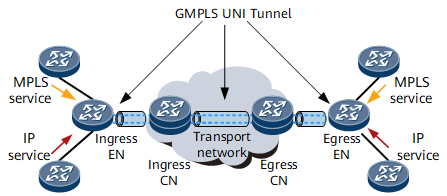General GMPLS UNI Scheme
GMPLS UNI allows IP services to be transparently transmitted over a transport network after the source EN and destination EN are configured based on the NMS. In this manner, new IP services do not need to be deployed for several months and burdensome negotiations between management departments of the IP network and transport network are not needed.
A GMPLS UNI tunnel is bidirectional so that both ends of the tunnel needs to be bound to logical GMPLS UNI interfaces and both logical interfaces need to be advertised to their respective IP networks. The statuses of the bound logical interfaces are associated with the GMPLS UNI status. If the UNI LSP is established, the bound logical interfaces go Up. If no UNI LSP is established, the bound logical interfaces go Down. In real-world situations, a GMPLS UNI tunnel is configured on logical interfaces in a way similar to the configuration of a routing protocol or the MPLS function on the logic interfaces. This merit makes the configuration of a GMPLS UNI tunnel more acceptable by users.
